
95% of researchers rate our articles as excellent or good
Learn more about the work of our research integrity team to safeguard the quality of each article we publish.
Find out more
ORIGINAL RESEARCH article
Front. Phys. , 12 May 2023
Sec. High-Energy and Astroparticle Physics
Volume 11 - 2023 | https://doi.org/10.3389/fphy.2023.1188989
The focus of this work was on investigating and comparing two methods for calculating the cross sections of muons produced by the decay of heavy-flavor hadrons in pp collisions, which cover the interval 2
The production of heavy quarks, due to their large mass, is a result of the initial hard parton scatterings that occur in high-energy collisions. The study of these events is conducted within the realm of perturbative quantum chromodynamics (pQCD), and the calculations are based on the factorization approach. The approach involves the evaluation of the hard parton scattering cross section as a perturbative series of the strong interaction’s coupling constant, combined with the parton distribution function (PDF) of the fragmentation function of heavy quarks to heavy-flavor hadrons and the colliding protons. These production cross sections are predicted at the next-to-leading order using the fixed-order plus next-to-leading logarithms approach [1–4]. The systematic uncertainties in these theoretical production cross sections are dominated by uncertainties in renormalization and factorization scales. The results in the forward rapidity region (2.5 < y < 4) allow for a test of pQCD predictions in a region of small Bjorken x, which can reach as low as 10–5, where the gluon distribution functions are affected by large uncertainties [5].
The comprehensive study of charm, beauty, and heavy-flavor hadron decay leptons, which has been conducted over a broad range of energies at the Tevatron, RHIC, and LHC ([6–17]), has shown that their production cross sections are in good agreement with pQCD-based predictions. This holds true both in the forward and central rapidity regions and across a wide range of transverse momentum (pT). The precise measurement of heavy-flavor production cross sections in pp collisions serves as the foundation for exploring the impact of cold nuclear matter effects as well as effects associated with the hot and strongly interacting medium in proton–nucleus and nucleus–nucleus collisions. These studies are essential in gaining a deeper understanding of the properties of the quark–gluon plasma.
In this study, our primary sources of data are from ALICE, one is the muon production cross section of produced heavy-flavor hadrons in pp collisions at 7 TeV, which cover the interval 2< pT < 12 GeV/c [19]. Another is the muon production cross section of produced heavy-flavor hadrons in pp collisions at 5.02 TeV, which cover the interval 2< pT < 20 GeV/c [20]. The results encompass the range 2< pT < 20 GeV/c, with the beauty contribution being predominant over the charm contribution at high transverse momenta (pT > 5 GeV/c) [4]. Furthermore, the present results have been obtained in a much broader pT range than earlier ALICE results for cross sections of muons from heavy-flavor hadron decays [18, 19].
Our article is organized as follows: in Section 2, we give a brief introduction to the FONLL prediction and uncertainty propagation. In Section 3, we show the energy scaling and pT extrapolation method to calculate heavy-flavor hadron decays producing muon cross sections in
The FONLL approach is widely used in high-energy physics to study the properties of heavy-flavor hadrons, such as charm and beauty mesons, and to make predictions of their differential decay rates into muons. Predictions for c and b quark production at the LHC have been presented in [4]. Recently, the ALICE collaboration has produced comparisons of distributions of leptons from heavy hadrons with FONLL predictions, i.e., muons in the forward rapidity region 2.5 < y < 4 [20] and electrons in the central region |y| < 0.8 [21].
In the FONLL [7] framework, the fixed order (FO) and next-to-leading logarithms (NLL) calculations are combined [1]. Schematically, the FONLL matching can be written as
where FO is the massive NLO calculation, RS is the massless resummed calculation, and FOM0 is the massless limit of FO. The subtraction of the massless limit FOM0 from the resummed (RS) approach ensures the αs log(pT/m) terms, present in both the fixed-order (FO) and RS calculations, are not double-counted. The function G(mQ, pT) is a damping function that serves to prevent artificially massless higher-order terms from providing an unphysically large contribution to the cross-section calculation.
Figure 4 shows the pT-differential production cross section at the muon level for charm and beauty, which has been obtained by taking into account the fragmentation and semi-muonic decays with the appropriate branching ratios.
There are three kinds of muon sources for the processes of heavy flavor hadron decay muons (μ ← c, b):
1. Muons from charm quarks: this source of muons is generated through the decay of charm quarks, with the decay chain represented as μ ← D ← c.
2. Muons from beauty quarks: this source of muons is generated through the decay of beauty quarks, with the decay chain represented as μ ← B ← b.
3. Muons from the indirect decay of beauty quarks: this source of muons is generated through the indirect decay of beauty quarks, with the decay chain represented as μ ← D ← B ← b.
We named these three kinds of muons as charm μ, beauty μ, and feed down μ, respectively. In order to make a fair comparison with experimental data, it is necessary to sum the production cross sections for all three types of muons. However, the uncertainties associated with each of these sources are not independent, so a straightforward quadratic propagation of errors is not possible. The procedure outlined in [22] is utilized for the proper propagation of uncertainties:
1. The central values of the production cross section of these three kinds of muons are combined to obtain the central value of the production cross section for muons from open heavy-flavor decays.
2. When determining the masses of quarks, it is possible to choose three distinct values for both mc and mb, resulting in a total of nine distinct combinations. By analyzing the maximum and minimum differences between these combinations, along with the central cross section value, it is feasible to derive the upper and lower bounds of uncertainty associated with the quark masses.
3. By independently adjusting the QCD scales for muons originating from charm and those from beauty (the beauty μ and feed down μ) while keeping the other parameters unchanged, it is possible to estimate the upper and lower uncertainties from the QCD scales,
After completing all of the aforementioned steps, the upper and lower uncertainties of the production cross sections of muons from heavy-flavor decays are obtained by quadratically adding the corresponding quark masses and QCD scales uncertainties. Because the QCD scales and quark masses uncertainties dominate in our chosen pT region, the uncertainties from PDFs are negligible in this work.
In order to obtain the reference cross section at
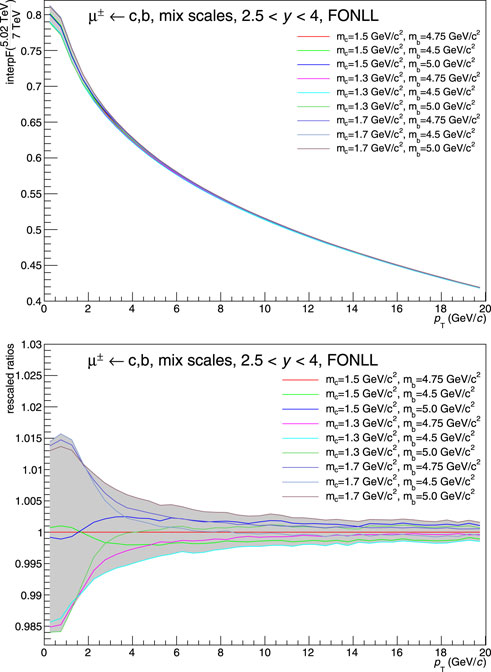
FIGURE 1. Upper: FONLL scaling factor from 5.02 TeV to 7 TeV for the measurement of the pT-differential cross section of muons from heavy-flavor hadron decays at forward rapidity (2.5 < y < 4) in pp collisions with different combinations of quark masses indicated in the figure. Bottom: corresponding relative systematic uncertainty.
The influence of the pQCD scale variations on the FONLL scaling factor was investigated in two cases: 1) the seven combinations for the QCD scales by mixing the QCD scales if we use the same scales for charm and beauty (correlated scales, colored lines in Figure 2) and 2) the 42 combinations for the QCD scales by mixing the QCD scales if we use different scales for charm and beauty (uncorrelated scales, black lines in Figure 2). At low pT (pT < 2 GeV/c), the uncertainty of the scaling factor reaches approximately 12%, while in the interval 2 < pT < 20 GeV/c, it is smaller than 4%.
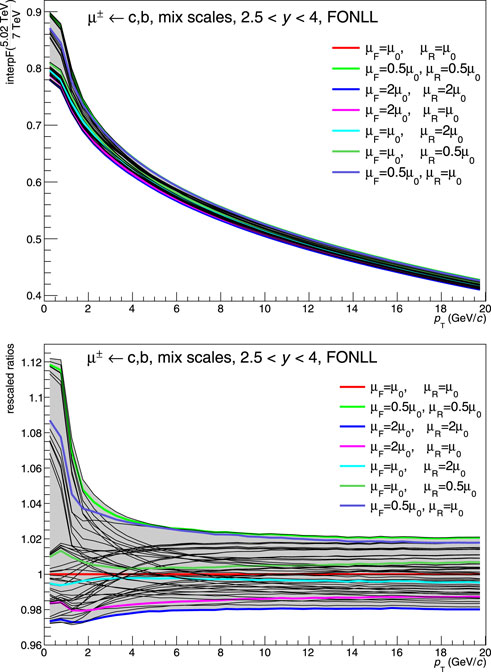
FIGURE 2. Upper: FONLL scaling factor from 5.02 TeV to 7 TeV for the measurement of the pT-differential cross section of muons from heavy-flavor hadron decays at forward rapidity (2.5 < y < 4) in pp collisions with different combinations of QCD scales, as indicated in the figure. Bottom: corresponding relative systematic uncertainty.
In summary, the FONLL scaling factor, as a function of pT, obtained for different sets of quark masses (green boxes) and pQCD scales (red boxes), as just discussed, is shown in Figure 3 (upper panel). The relative systematic uncertainty of the scaling factor is also shown in the bottom panel of the figure (gray band); we can observe that the QCD scale uncertainty evidently dominates over the quark mass uncertainties.
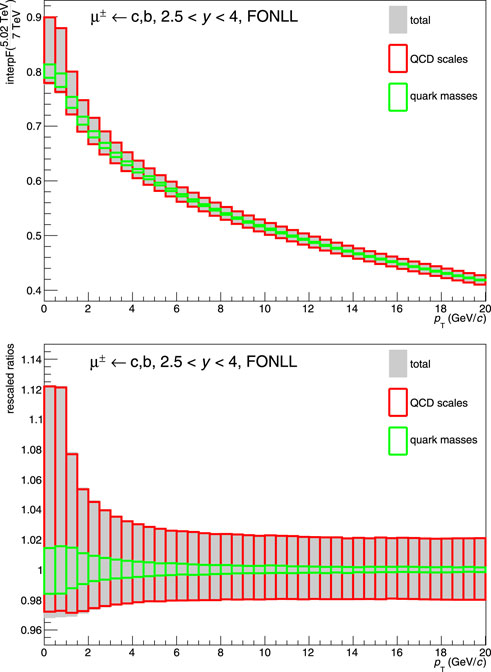
FIGURE 3. Upper: FONLL scaling factor from 5.02 TeV to 7 TeV for the measurement of the pT-differential cross section of muons from heavy-flavor hadron decays at forward rapidity (2.5 < y < 4) in pp collisions with different combinations of QCD scales (red boxes) and quark masses (green boxes). The gray band is the total systematic uncertainty. Bottom: corresponding relative systematic uncertainty.
The pT-differential cross section of heavy-flavor decay muons in 2 < pT < 12 GeV/c in pp collisions at
First, we determine the ratio between the published
Different fit ranges were used to extract the K7TeV factor, as reported in Table 1. Finally, the pp reference in the 12 < pT < 20 GeV/c range is obtained using the K7TeV value (Table 1), which is 1.28. Then, the pp reference in the pT extrapolated region is
The upper panel of Figure 4 displays the production cross section of muons from heavy-flavor decays in pp collisions at 5.02 TeV and 7 TeV, obtained from FONLL predictions. The pT-differential cross section of muons from heavy-flavor hadron decays at
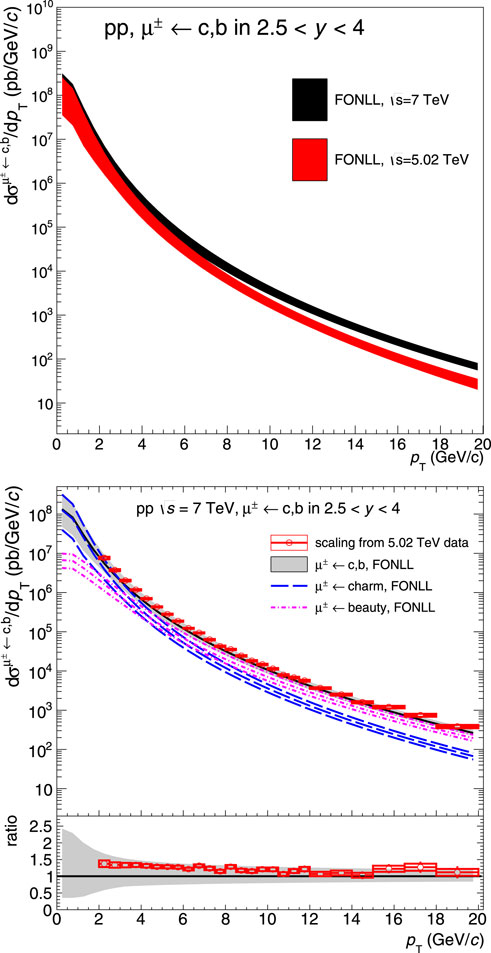
FIGURE 4. Upper: pT-differential cross section of muons from heavy-flavor hadron decays in pp collisions at
The results are in agreement with FONLL calculations within uncertainties, although the data lie at the upper limit of the model predictions, as already observed at other center-of-mass energies.
With the pT extrapolation method, the pT-differential cross section of muons from heavy-flavor hadron decays at forward rapidity (2.5 < y < 4) in pp collisions at
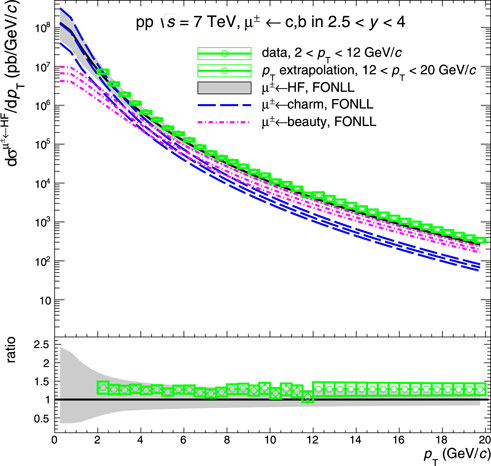
FIGURE 5. Heavy-flavor hadron decay muons that cover the interval 2 < pT < 12 GeV/c at
In summary, with the published measurements and FONLL predictions, we use the energy scaling and pT extrapolation method to calculate the cross section of muons from heavy-flavor hadron decays at forward rapidity (2.5 < y < 4) in pp collisions at
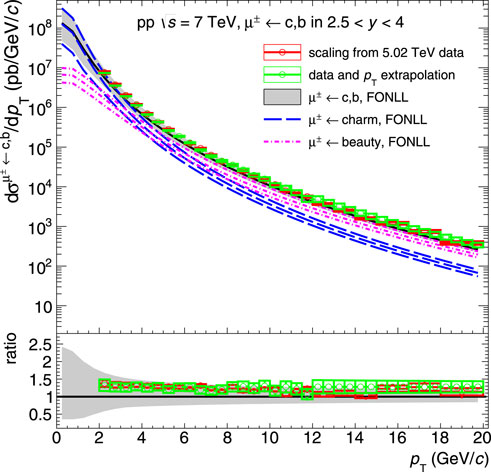
FIGURE 6. pT-differential cross section of muons from heavy-flavor hadron decays at forward rapidity (2.5 < y < 4) in
The original contributions presented in the study are included in the article/Supplementary Material, further inquiries can be directed to the corresponding author.
ZZ analyzed the simulation data and wrote the manuscript. All authors contributed to the article and approved the submitted version.
This work is supported in part by the Natural Science Foundation of Henan Province (no. 212300410386), the Key Research Projects of Henan Higher Education Institutions (no. 20A140024), the NSFC Key Grant 12061141008, and the Scientific Research Foundation of Hubei University of Education for Talent Introduction (no. ESRC20220028 and ESRC20230002).
The authors declare that the research was conducted in the absence of any commercial or financial relationships that could be construed as a potential conflict of interest.
All claims expressed in this article are solely those of the authors and do not necessarily represent those of their affiliated organizations, or those of the publisher, the editors, and the reviewers. Any product that may be evaluated in this article, or claim that may be made by its manufacturer, is not guaranteed or endorsed by the publisher.
1. Cacciari M, Greco M, Nason P The pT spectrum in heavy flavor hadroproduction. JHEP (1998) 05:007. doi:10.1088/1126-6708/1998/05/007
2. Cacciari M, Nason P Charm cross-sections for the Tevatron run II. JHEP (2003) 09:006. doi:10.1088/1126-6708/2003/09/006
3. Cacciari M, Nason P, Oleari C A study of heavy flavoured meson fragmentation functions in e+e− annihilation. JHEP (2006) 04:006. doi:10.1088/1126-6708/2006/04/006
4. Cacciari M, Frixione S, Houdeau N, Mangano ML, Nason P, Ridolfi G Theoretical predictions for charm and bottom production at the LHC. JHEP (2012) 10:137. doi:10.1007/jhep10(2012)137
5. Cacciari M, Mangano ML, Nason P, “Gluon PDF constraints from the ratio of forward heavy-quark production at the LHC at
6. Andronic A, Arleo F, Arnaldi R, Beraudo A, Bruna E, Caffarri D, et al. Heavy-flavour and quarkonium production in the LHC era: From proton–proton to heavy-ion collisions,” Eur Phys J C76 no. 3, (2016) 107, doi:10.1140/epjc/s10052-015-3819-5
7.CMS Collaboration Khachatryan V, et al. “Measurement of the total and differential inclusive B+ hadron cross sections in pp collisions at
8.ATLAS Collaboration Aad G, et al. “Measurement of D*±, D± and
9.ALICE Collaboration Acharya S, et al. “Measurements of low-pT electrons from semileptonic heavy-flavour hadron decays at mid-rapidity in pp and Pb-Pb collisions at
10.ALICE Collaboration Abelev B, et al. “Measurement of electrons from beauty hadron decays in pp collisions at
11.ALICE Collaboration Acharya S, et al. “$\upLambda_{\mathrm{c}}^+$ production in pp collisions at $\sqrt{s} = 7$ TeV and in p-Pb collisions at $\sqrt{s_{\spmathrm{NN}}} = 5.02$ TeV,” JHEP 04 (2018) 108.
12.ALICE Collaboration Acharya S, et al. “First measurement of
13.ALICE Collaboration Acharya S, et al. “Measurement of D-meson production at mid-rapidity in pp collisions at
14.ALICE Collaboration Adam J, et al. “D-meson production in p-Pb collisions at
15.LHCb Collaboration Aaij R, et al. “Prompt charm production in pp collisions at
16.LHCb Collaboration Aaij R, et al. “Measurements of prompt charm production cross-sections in pp collisions at
17.LHCb Collaboration Aaij R, et al. “Measurements of prompt charm production cross-sections in pp collisions at
18.ALICE Collaboration Abelev B, Adamová D, Adare AM, Aggarwal MM, Aglieri Rinella G, et al. Production of muons from heavy flavor decays at forward rapidity in pp and Pb-Pb collisions at sqrt[s(NN)]=2.76 TeV
19.ALICE Collaboration Abelev B, et al. “Heavy flavour decay muon production at forward rapidity in proton–proton collisions at
20. Acharya S, Adamová D, Adler A, Adolfsson J, Aggarwal MM, et al. Production of muons from heavy-flavour hadron decays in pp collisions at
21. Acharya S, Adamová D, et al. “Measurement of electrons from semileptonic heavy-flavour hadron decays at midrapidity in pp and Pb-Pb collisions at
Keywords: General properties of QCD, FONLL, heavy-flavor hadron decays, muon, cross sections, pp collisions, high transverse momentum
Citation: Zhang Z, Li S, Yu N and Zhu Z (2023) Heavy-flavor hadron decays producing muon cross sections in pp collisions at high transverse momentum. Front. Phys. 11:1188989. doi: 10.3389/fphy.2023.1188989
Received: 18 March 2023; Accepted: 19 April 2023;
Published: 12 May 2023.
Edited by:
Choong Sun (C. S.) Kim, Yonsei University, Republic of KoreaReviewed by:
Atanu Pathak, Purdue University Northwest, United StatesCopyright © 2023 Zhang, Li, Yu and Zhu. This is an open-access article distributed under the terms of the Creative Commons Attribution License (CC BY). The use, distribution or reproduction in other forums is permitted, provided the original author(s) and the copyright owner(s) are credited and that the original publication in this journal is cited, in accordance with accepted academic practice. No use, distribution or reproduction is permitted which does not comply with these terms.
*Correspondence: Ning Yu, bmluZy55dWNoaW5hQGdtYWlsLmNvbQ==; Zuman Zhang, enVtYW4uemhhbmdAaHVlLmVkdS5jbg==; Sha Li, bGlzaGFAaHVlLmVkdS5jbg==
†These authors have contributed equally to this work
Disclaimer: All claims expressed in this article are solely those of the authors and do not necessarily represent those of their affiliated organizations, or those of the publisher, the editors and the reviewers. Any product that may be evaluated in this article or claim that may be made by its manufacturer is not guaranteed or endorsed by the publisher.
Research integrity at Frontiers

Learn more about the work of our research integrity team to safeguard the quality of each article we publish.